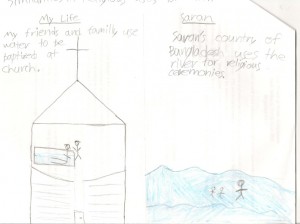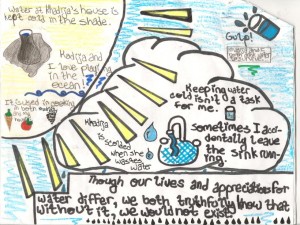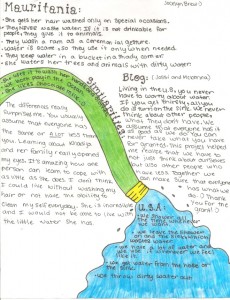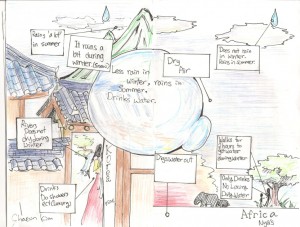Multicultural Literature in the Secondary Science Classroom: Connections to Content and Culture
By Jennifer Hart Davis
Water, we cannot live without it, yet few of us really understand or stop to consider our relationship with the natural resource that ties humanity together. Water is the very essence of life. While many of us in the developed world take our unlimited access to clean water supplies for granted, there is a water crisis in much of the world. What connection and responsibility do we have to our global neighbors with whom we share this resource? It was this globally unifying topic of water through which I sought to connect content and culture in my science classroom.
My goal in integrating multicultural literature into my eighth-grade Earth Science curriculum was to allow students to not only access science content (water cycle; global climate and weather patterns) but also to connect in a deeper way to the experiences and perspectives of young people in other cultures (cultural practices, adaptations). By making connections to their own and then other cultures, my hope was that students would be able to feel and develop respect for the “common humanity” (Short, 2009) that comes from the sharing and care of our natural resources.
I spent the first twenty years of my career conducting research in soil and water quality. It was only recently that I discovered my passion for teaching. During my first year as a teacher, pulling multicultural literacy into my science classroom was an ideal I had to implement intentionally–my background as a practicing scientist grounded the foundations of science as being unequivocally technical and objective in nature. In my observation and attempted explanation of the natural world, I sought to remove the subjective nature of the human condition from my research and writings thereby making the dissemination of scientific information as close to the “truth” as possible. However, as I guide the next generation of citizen scientists, I found that I needed ways to integrate the objective nature of science with an understanding of how we, as a society, shape and are shaped by scientific information. Decisions and policies we create regarding natural resources are intricately woven into human placement of value on these resources. The problem is that there is not always a clear pathway to integrate culture into teaching science content.
I have been on a journey in my short tenure as an educator to gain a better understanding myself of what culture is and how I can marry that understanding with my passion for social justice. Short (2003) states that culture is a “design for living that involves ways of acting, believing and valuing” (p.2). In order for my students to make socially responsible decisions, they must be able to step beyond their own experiences and not only see how their decisions impact others but to also empathize with those ‘others’. Exposure to multicultural literature is one pathway to make this possible. By exploring the value that global cultures place on water, my students will hopefully be able to consider water resource issues from a global perspective.
The availability of water clearly shapes culture. An excerpt from Our World of Water by Beatrice Hollyer (2008) included this statement: “We have a funny human habit of valuing only what seems rare to us, things like masterpieces of art or diamonds. We think that water is so very common that we needn’t value it so highly” (p. 6). This passage set the stage for my students to consider both how and on what we and other cultures place value. In our local culture in the Willamette Valley of Oregon, water scarcity is not our greatest worry; the fact that we can experience droughts that will likely increase with global warming goes unnoticed by most. It is this perceived abundance of water that I predicted would lead my students to take the water flowing out of their taps for granted and inhibit them from seeing the interconnectedness of their lives with others around the world. Water never seems to be in short supply so why should they care? Yet at the same time, according to the FAO (Food and Agriculture Organization of the United Nations), 1,800 million people will be living with “absolute water scarcity” by the year 2025.
In order to fully explore the interconnectedness of culture and resources, it was critical that I find and use “authentic” literature. I knew students would encounter narratives from students who had access to fewer resources than they do. I did not want my students to pity the young people they read about, rather, I wanted them to feel connected to and develop a respect for the ability of humans to adapt to their natural environments. I also wanted them to become aware of the role that water takes in shaping culture. My students first had to examine and appreciate their own culture before they could truly connect with others in a meaningful way (Short, 2009).
The first activity for my students was to explore and record how they, their family and community used water over a long weekend. For this exercise, I provided seven questions that prompted them to consider how they use water to survive and make their lives healthier, as a luxury, in ceremonial or religious ways, and also to consider how they waste water. The questions included:
How did you use water in ways that allowed you to survive (needs)?
How did you use water in ways that allowed you to make life healthier?
How did you and your family use water in ways that you would consider a luxury and not a necessity (wants)?
How did you waste water?
Does your family ever use water in any type of ceremonial way? If so, how?
Do you play in water? How? What kind?
How valuable do you think water is as a natural resource in Corvallis? In the United States? In the World?
Classroom discussions afterwards centered on the more obvious ideas of drinking water and using it to shower and brush their teeth. At this point in the lesson, students did not appear to be very engaged. I would summarize their attitude as, “Yes, I use water just like everyone else, so what?” They had a harder time initially considering how their use of water might be considered a luxury or a waste and there were few responses as to how they might use water in ceremonial or religious practices. Overall, students felt as though their use of water was relatively efficient and necessary to sustain their everyday life. One goal of using multicultural literature is to have students’ perceptions change to an understanding that their experience is not the only one and that, quite frankly, is not the “norm” in terms of global averages. The reality is that globally, one in eight people do not have access to safe water supplies (UNICEF/WHO, 2008).
The next step in the lesson was to have students dive in to the literature. The two books I selected for whole class study were A Long Walk to Water by Linda Sue Park (2010) and Our World of Water: Children and Water around the World by Beatrice Hollyer (2008). In A Long Walk to Water, students focused on the narrative of Nya, a young woman from Sudan who was solely responsible for supplying her family with water, at times walking eight hours a day through the desert. Each chapter of Our World of Water contained an in-depth look at the life of a child from one of several countries including Peru, Mauritania, Bangladesh, Ethiopia, and Tajikistan. These authentic texts explored more than the superficial “tourist perspective” (Short, 2009) and considered fully the everyday lives of the children and their relationships with water. I was somewhat surprised by my students’ excitement at the text selections. These texts were so different than the science content pieces they were used to reading and their reaction demonstrated how personal narratives grab their attention and allow them to connect more easily to the text. This was an exciting discovery for me.
Students read the texts in small groups and answered the same questions they had answered for themselves about water use, this time from the perspective of the child about whom they read. I chose to have students identify similarities and differences between their and their counterparts’ relationship with water. According to Marzano, et al. (2001) when students work independently to identify similarities and differences and then represent these findings in a graphic way “students’ understanding of and ability to use knowledge” (p. 15) is enhanced. Using a student-led activity increases the pureness of the individual’s reflection and the overall diversity of responses that can then expand and enrich individual perspectives when shared in whole group settings. The final product of this lesson was the graphic representation of these similarities and differences. I left the style and format of the product open to allow students to express their thoughts in a way that was organic for them.
The comments I heard during the reading of the texts were exciting and illustrated that students were awed by what some kids had to go through to get water. I repeatedly heard comments such as: “All I have to do is walk to the sink to get water; they have to work so hard!”; “Can you believe she has to walk all that way without shoes?”, “Yeah, and then she had to take her little sister with her!”; “I can’t imagine not being able to take a shower whenever I wanted!”; “They are so careful with water, they even use the leftovers to wash themselves.” I felt that students were really stepping into the lives of these kids in other regions of the world.
The products students created demonstrated that their perspectives on their own relationship with their culture surrounding water had grown in depth, diverging from their initial, more obvious observations. They were able to go from focusing on merely drinking water to survive to considering use of water for religious purposes and celebrations. There was also a great shift in their categorizing of their use of water as “wants” and “needs.” The strongest shift was in their realization that many of their uses of water would, to the rest of the world, be considered a luxury. Swimming in a pool, taking showers every day, watering lawns and having access to clean water are luxuries that many around the world do not enjoy. Students also better understood the high value placed on water in these cultures and the ability of these children to use water carefully and still lead fulfilling, rich lives. Learning about the care that kids in other cultures gave to using water gave my students a new perspective on what wasting water in their own lives looked like. Reflections on the project included the following responses from my 14 year old students:
Doing this project has really changed my perspective on how we use water. For example, I didn’t realize how valuable it is to people in Ethiopia. They have to walk long ways just to find small ponds, while we can access it by turning on our sinks. I also realized that we take water for granted. We sometimes leave the sink running while we brush our teeth or take a long shower. So this project has made me think twice when I use water and think if I need to use it or not. Matt
In the water unit I learned that water in some countries is so scarce that people fight over it. While in the U.S., you can take a few steps to the sink and have water pour out of the spout; as much as you want. To most people in the U.S., water doesn’t seem very valuable . . . Randall
I found it interesting how other cultures are so much more careful about using water, even if they don’t live in an area where water is a problem. Michaela
I thought that it might be easier for students to identify the differences between themselves and their counterparts before their similarities. I was very happy to see that the literature allowed students to discover interesting commonalities. Jacob, a student with autism, recognized that he and Saran of Bangladesh use water for religious ceremonies. Jossi added that in Kadja’s culture of Mauritania, they use water to wash rams for ceremonial purposes.
Figure 1. Jacob related that he and Saran from Bangladesh both use water for religious ceremonies.
Beverly noted that she and Kadja love to play in the ocean and both use water to prepare their food. Bev concluded that “This article opens my eyes to the fact that I take water for granted when I should really treasure it for keeping me alive.”
Figure 2. Beverly, who loves to cook, noted how important it was for her and Kadja to use water to prepare food.
Jossi was able to envision Khadja’s very different relationship with water. The depth of Jossi’s new perspective was summed up in her comment: “Learning about Khadja and her family really opened my eyes. It’s amazing how one person can learn to cope with as little as she does. She is incredible and I would not be able to live with the little water she has.”
Figure 3. Jossi was able to really envision Khadja’s very different relationship with water.
Chaeun Kim, a Korean student who is an English Language Learner, did a beautiful job expressing the similarities and differences between her Korean culture and Sudan. We used this opportunity to discuss how her relationship with water in Korea is very similar to the U.S.
Figure 4. Chaeun beautifully depicted similarities and differences between her Korean experience with water resources and that of Nya’s in Sudan.
I am so pleased with the outcome of my first use of authentic multicultural literature in the science classroom. I felt that I met my goals of having students understand science content as well as develop a deeper connection to other cultures. Using this literature clearly allowed my students easier access to the content, and by gaining an understanding and appreciation for these individuals’ culture, changed their perspective of their own relationship with water. It is my hope that this transformation will raise their awareness of global water resource issues. Although I have begun my adventures in using critical literacy with this single unit, my goal is to achieve the “international mindedness” as described by Short (2003, p.1) so that these multicultural perspectives “permeate” my curriculum and allow my students to “recognize their common humanity” (Short, 2009).
References
Hollyer, B. (2008). Our world of water: Children and water around the world. New York: Henry Holt and Company, LLC.
Marzano, R. J., Pickering, D. J., & Pollock, J. E. (2001). Classroom instruction that works: Research-based strategies for increasing student achievement. Upper Saddle River, New Jersey: Pearson.
Park, L. S. (2010). A long walk to water. New York: Clarion Books.
Short, K. G. (2003). Exploring a curriculum that is international. IBO World.
Short, K. (2009). Critically reading the word and the world: Building intercultural understanding through literature. Bookbird: A Journal of International Children’s Literature, 47(2), 1-10.
UNICEF/WHO. (2008). Progress on Drinking Water and Sanitation: Special Focus on Sanitation.
Dr. Jennifer Hart Davis is a science teacher at Crescent Valley High School in Corvallis, Oregon. Before becoming a teacher, she worked in applied research as a soil scientist.
WOW Stories, Volume IV, Issue 2 by Worlds of Words is licensed under a Creative Commons Attribution-NonCommercial-ShareAlike 4.0 International License.
Based on a work at https://wowlit.org/on-line-publications/stories/storiesiv2/.




